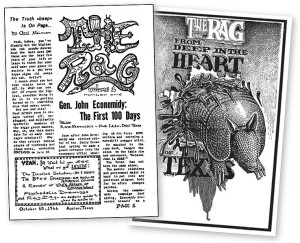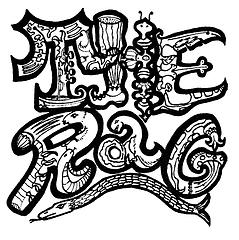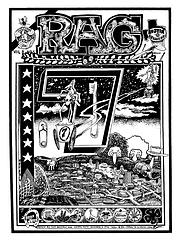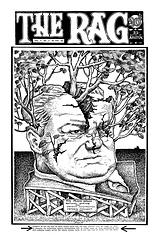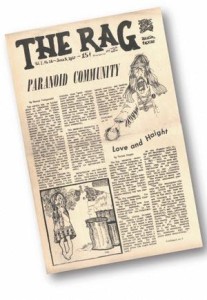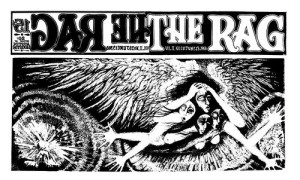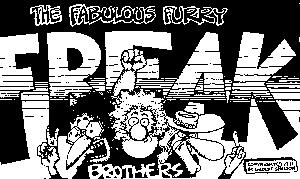The Rag Online
The Rag can be found online in the Independent Voices collection on JSTOR.
The Rag and its digital rebirth
By Thorne Dreyer | Editor, The Rag Blog
The Rag Blog and Rag Radio are an unprecedented digital age rebirth of The Rag, a pioneering underground newspaper published in Austin, Texas, from 1966-1977.
In his 1972 book, The Paper Revolutionaries, Laurence Leamer wrote that The Rag was “one of the few legendary undergrounds,” and in 2010, the Austin Chronicle‘s Kevin Brass called the paper “a firebrand little troublemaker” that was “a seminal influence in the national underground press movement.”
Noted for its unique blend of New Left politics and Sixties alternative culture – presented with a hearty dose of irreverent Texas humor and psychedelic art – The Rag was among the earliest and most influential of the Sixties-era underground newspapers; it was the sixth member of the Underground Press Syndicate (UPS) and the first underground paper in the South.
Historians have also noted that The Rag was the first of the underground papers to grow directly out of an activist and counterculture community — and the first to eschew traditional top-down editorial structure and be run democratically by its staff.
What they say about The Rag!
The Rag certainly wasn’t slick — and its name opted for irony over elegance — but this brash little upstart would introduce to Austin a new kind of journalism — passionate and involved — and its impact on the community would be felt for decades to come.
The Rag’s original editors, who were tagged “funnels” in keeping with the paper’s democratic sensibilities, were Thorne Dreyer and Carol Neiman. Dreyer now edits The Rag Blog and is host and producer of Rag Radio, and many of the paper’s original contributors are involved in its new online incarnation.
The Rag Reunion
On Labor Day weekend 2005, dozens of former staffers and fellow travelers of The Rag came together in Austin – from parts far and wide – to attend a wildly-successful four-day Rag Reunion.
Legions of grizzled ‘old-schoolers’ gathered to relive the past glories of the underground press and the good old days of Austin culture…
Legions of grizzled “old-schoolers” gathered — appropriately enough at Austin’s Old School — to relive the past glories of the underground press and the good old days of Austin culture (“back when Austin was really cool!”) in a series of spirited meetings and social events.
The Rag Reunion featured a vintage Rag art show at the South Austin Popular Culture Center; an exhibit of former staff shutterbug Alan Pogue’s widely-acclaimed documentary photojournalism; and a retro-rock concert featuring legendary psychedelic rockers Shiva’s Headband and the Uranium Savages, staged at the venerable Austin music venue, Threadgill’s.
But, most important, the Rag Reunion reignited old fires and started some new ones, as erstwhile colleagues renewed contacts, energy, and commitment, all of which would lead to a unique rebirth of The Rag for the digital age.
The little paper that could
The Rag was the little paper that could. Founded in 1966, it was a formative force in the Austin counterculture and a major player in the national underground press of the 1960s and ‘70s – a significant and perhaps under-recognized chapter in the history of American journalism.
According to John Gordon Burke, writing in his 1972 book, Essays on Media, “The most spectacular occurrence in recent journalism was the overnight emergence of the underground press.” And the New Yorker’s Louis Menand called the underground press movement “one of the most spontaneous and aggressive growths in publishing history.”
Starting with a handful of raggedy upstart newspapers, mostly on the East and West Coasts, the underground press spread like wildfire throughout the country, with papers appearing in cities big and small, on college and high school campuses, and on military bases. There eventually were several hundred papers with a combined readership that reached well into the millions.
The Rag is now recognized by historians as one of the seminal underground papers, vital and authentic…
The Rag is now recognized by historians as one of the seminal underground papers, vital and authentic, and especially noted for its unique blend of radical politics, alternative culture, and humor.
Historian John McMillian, author of Smoking Typewriters: The Sixties Underground Press and the Rise of Alternative Media in America, a landmark history of the underground press movement published in 2011 by Oxford University Press, called The Rag “a spirited, quirky, and humorous paper, whose founders pushed the New Left’s political agenda even as they embraced the counterculture’s zeal for rock music, psychedelics, and personal liberation.”
According to McMillian, the Austin community “came to regard [The Rag] as a beautiful and precious thing.”
Visit the Rag Archives website.
Thorne Dreyer and Victoria Smith, in an essay published by Liberation News Service in 1969, reported that “the people who put The Rag together were the same people who conceived demonstrations and love-ins, who were among the leaders of confrontations with local authorities, and who were at the forefront of local cultural gatherings.”
And Austin activist and founding Ragstaffer Alice Embree said, “The Rag covered what was not covered by the ‘straight’ press. The writers participated in the political and cultural uprising and also wrote about it. And they told you where to get a chicken dinner for 35 cents.”
Historian Abe Peck called The Rag the “first undergrounder to represent the participatory democracy, community organizing and synthesis of politics and culture that the New Left of the midsixties was trying to develop.” And Blake Slonecker, in his 2013 book about Liberation News Service, A New Dawn for a New Left, said that The Rag “shaped the Movement’s cultural politics in Austin.”
Making Austin weird
Austin, long famed for its “weirdness,” is now home to South by Southwest and Austin City Limits and is known as the “live music capital of the world.” But the city has always been a haven for bohemians, iconoclasts, and literary types. And, in the Sixties, Austin was also the center of a large and very active New Left political community based at the University of Texas campus – with one of the largest and most influential SDS chapters in the country.
Austin was the site of early civil rights demonstrations – including the movie theater “Stand-Ins” on the University “drag” in 1960-’61 — and was a hotbed of activity against the War in Vietnam and an early center for the feminist and anti-nuclear movements.
The now legendary “Gentle Thursday” gatherings on the UT-Austin campus – organized by SDS and The Rag – united hipsters and politicos and inspired similar activities at other campuses around the country, and a massive 1967 SDS-generated student free speech uprising (the University Freedom Movement) mobilized thousands of students in massive demonstrations and other activities on and around the UT campus.
Austin was also a major player in the Sixties drug and music culture – incubating talents like Janis Joplin and the Thirteenth Floor Elevators – and was a center for innovative graphic arts and the underground comix movement.
And The Rag united those diverse communities into a potent political force.
The Rag hits the streets
In the summer of 1966, Thorne Dreyer and Carol Neiman, along with Dennis and Judy Fitzgerald, participated in an SDS summer project in San Francisco’s Haight-Ashbury where they met Michael Kindman, whose Paper in East Lansing, Michigan, was one of the original underground papers and the first to come out of a university community.
They also consulted with Berkeley Barb editor Max Sheer and others – and returned to Austin convinced that The Rag would be just the thing to pull together the diverse Austin movement community.
The need became even more apparent after a pro-war right-winger, John Economidy, was elected editor of the Daily Texan, the UT newspaper with a long and storied tradition of crusading liberal editors. Dreyer later told the Austin Chronicle that Economidy “offered himself as an alternative to ‘another female editor,’” and that he “turned the Texan‘s editorial pages into a mouthpiece for the university’s information service.” Outgoing (female!) Texan editor Kaye Northcott would profile Economidy’s takeover of the Daily Texan as the lead story in The Rag’s first edition.
Table of Contents of The Rag
The time was clearly ripe for The Rag. The first issue of the paper, published on a small multilith offset press owned by shaggy Ragstaffer Larry Freudiger, hit the Austin streets on October 10, 1966. The first issue sold out immediately and another press run was ordered, and The Rag was an instant hit.
The paper quickly established itself as an invaluable source for alternative news and opinions…
The paper quickly established itself as an invaluable source for alternative news and opinions, an outlet for local writers and artists, and an organizing tool for the rapidly growing movement for change. And, from the beginning, the Rag office doubled as a community center and neighborhood hangout. An ever-growing cadre of volunteers joined in uber-democratic staff meetings and layout sessions, and legions of vendors would head to the Rag office to pick up papers to sell on the drag and at community events.
Bill Meacham, then a UT grad student who also wrote for The Rag, told the Austin Chronicle, “Whoever showed up could just be part of it. It was very open in that sense,” And former staffer Harvey Stone said, in a film about The Rag made by People’s History in Texas, “We not only wrote about the news, but we were making the news. We would organize a demonstration, we would be at the demonstration, and we’d come back and write about the demonstration.”
The Rag exemplified an involved form of journalism. In fact, the underground press as a rule eschewed traditional “objectivity” as an unworthy and, for that matter, unattainable goal. In 1968, The New York Times quoted Thorne Dreyer saying that “objectivity is a farce.” And Susan Torian Olan wrote in a UT Masters thesis about The Rag, that “the underground press must be seen not only as part of a rebellion in society but also as part of a rebellion within journalism. I found no evidence, not even hearsay, that the Rag ever once even pretended to objectivity nor that it ever shrank from creating the news it reported.”
The Rag regularly featured news coverage and commentary on the War in Vietnam and the movement opposing it, the civil rights struggles, the student freedom movement, the growth of the New Left and SDS, the psychedelic rock and folk music scenes, and the sixties counterculture movement. The paper also carried national and world news and opinion from Liberation News Service (LNS) and from other underground newspapers around the country, through the Underground Press Syndicate (UPS).
The Fabulous Furry Freak Brothers, Gilbert Shelton’s iconic sixties comic strip, was born in The Rag and surrealist graphic artist Jim Franklin – who almost single-handedly transformed the lowly armadillo into a symbol for the Texas counterculture — designed many of the paper’s covers. The Rag also featured the work of noted graphic artist Kerry Awn, underground comix pioneer Jack Jackson (Jaxon), and noted documentary photographer Alan Pogue.
Contributors to The Rag included nationally-influential Austin-based activists like Gary Thiher, Jeff Shero (later Jeff Nightbyrd), Robert Pardun, Greg Calvert, Alice Embree, Mariann Vizard (now Mariann Wizard), and Dreyer and Neiman, as well as national political figures and literary voices ranging from Abbie Hoffman and Tom Hayden to Charles Bukowski, Tuli Kupferberg, and Diane di Prima.
Over its life span the paper evolved with the times, becoming one of the strongest voices of the women’s liberation movement and later focusing on local politics, covering Austin city government, neighborhood protests, and the labor movement.
Rag Bibliography
As filmmaker and former Ragstaffer Glenn Scott recalled about The Rag’s later days, one “could not have imagined a more democratic process than a Rag copy meeting. An all-volunteer group of self-taught editors and copy writers debated the sexism and violence in pornography, the corporate influence in utility policies, and the CIA’s involvement in Chile. And how much space went to the Free Clinic benefit and the Freak Brothers.”
In 1970, the regents at the University of Texas sued The Rag to prevent the paper being sold on campus and famed civil liberties attorney David Richards successfully defended the paper’s First Amendment rights before the U.S. Supreme Court. Working with attorney Sarah Weddington, staffers at The Rag were also instrumental in crafting the landmark abortion rights case, Roe v. Wade.
Historian John McMillian said that The Rag served as a model for many papers that would come after it…
Historian John McMillian said that The Rag served as a model for many papers that would come after it, and former staffers were directly involved in two of the most important of the second generation of underground newspapers. Thorne Dreyer and Dennis and Judy Fitzgerald were founding editors of Space City! in Houston, while Jeff Nightbyrd, Alice Embree, and Gary Thiher were prime movers at New York’s RAT. Original Rag “funnella” Carol Neiman later edited the SDS national newspaper, New Left Notes.
Jeff Nightbyrd and Michael Eakin would start up the Austin Sun in 1974, a paper with special emphasis on Austin’s burgeoning music scene, and the transition from “underground” to “alternative” was complete when the Austin Chronicle was started in 1981. (The Chronicle is still going strong in 2013.) There was substantial continuity in concept, staff, and audience from The Rag through the Sun to the Chronicle — which now reaches more than 200,000 people.
As prominent UT law professor and immigration attorney — and former Ragstaffer – Barbara Hines said, “I think [The Rag] was important because it was the beginning of alternative press.”
The Rag Blog
Initiated in 2006 by Alice Embree after the Rag Reunion – and originally edited by Richard Jehn – The Rag Blog quickly grew into an influential progressive online newsmagazine with an international following. Before moving to its new location at TheRagBlog.com in January 2014, The Rag Blog had already seen more than 10,000 posts and had hosted nearly 2 million unique visits. The Rag Blog has featured the work of over 150 writers, many of them veterans of the original Rag and the Sixties underground press and New Left.
Regular contributors have included Paul Krassner, Tom Hayden, Carl Davidson, Mike Davis, Jonah Raskin, Judy Gumbo Albert, Robert Jensen, Bruce Melton, Harry Targ, and the late John Ross. And former Ragstaffers Alice Embree, Roger Baker, Mariann Wizard, Sarito Carol Neiman, William Michael Hanks, and Alan Pogue have been Rag Blog regulars.
Jim Retherford, another veteran of the Sixties underground press who edited Rag contemporary The Spectator in Bloomington, Indiana, is The Rag Blog’s graphic designer.
Melanie Scruggs wrote in 2012 that “The Rag simply went dormant, and in fact, has come to life… as a blog initiated at the Rag Reunion… The Rag legacy carries onward even as so few people of the new Austin generation appreciate the impact that it had on their city and so much of what makes it a vibrant place to live.”
Historian and graphic novel publisher Paul Buhle said that “The Rag Blog is in many ways what The Rag was in the middle 1960s, a light in the darkness…”
Noted historian and graphic novel publisher Paul Buhle said in 2009 that “The Rag Blog is in many ways what The Rag was in the middle 1960s, a light in the darkness… not only readable but funny,” calling it “the best place for insights in the entire blogosphere that I follow.”
In a June 2012 feature, CultureMap Austin named The Rag Blog Austin’s best political blog. Pointing out that editor Thorne Dreyer and The Rag “both came of age in the tumultuous sixties,” author Shelley Seale wrote: “The Rag Blog features commentary on contemporary politics and culture and has been an original internet source on subjects like Occupy Wall Street, the environmental and sustainability movements, and other issues of social activism.”
The Rag Blog can be contacted at editor@theragblog.com
Rag Radio
Rag Radio is a syndicated weekly radio show that has aired since 2009. It features hour-long in-depth interviews and discussion about issues of progressive politics, culture, and history, with guests including newsmakers, artists, leading thinkers, and public figures – from Austin, Texas, and around the world.
Guests have included populist commentator Jim Hightower, political economist Gar Alperovitz, singer-satirist Kinky Friedman, singer-songwriter Eliza Gilkyson, composer and Beat pioneer David Amram, sociologist Todd Gitlin, Port Huron author Tom Hayden, Realist editor Paul Krassner, and newsman Dan Rather, interviewed with his daughter, Austin-based environmentalist Robin Rather.
Rag Radio is broadcast and streamed live every Friday from 2-3 p.m. (Central time) on KOOP 91-7 FM, an all-volunteer cooperatively-run community radio station in Austin, and is rebroadcast and streamed Sundays at 10 a.m. (Eastern) on WFTE, 90.3-FM in Mt. Cobb, PA, and 105.7-FM in Scranton, PA. and by Houston Pacifica station KPFT’s HD-3 channel on Wednesdays at 1 p.m. (Central). Rag Radio also has a widespread Internet following and all episodes are posted as podcasts at the Internet Archive.
Rag Radio is produced and hosted by Rag Blog editor Thorne Dreyer. Tracey Schulz is engineer and co-producer.
Rag Radio can be contacted at Ragradio@koop.org.
New Journalism Project
The Rag Blog and Rag Radio are produced and supported by the New Journalism Project, a Texas 501(c)(3) nonprofit corporation. With these two platforms the NJP has built an interactive digital community with national and international participation. And in Austin, a lively non-virtual activist Rag community has been fostered through a continuing series of public events, social gatherings, and concerts.
Followers are encouraged to become a part of The Rag Blog and Rag Radio — by going here and donating to the NJP through PayPal. Or by sending a check to: The New Journalism Project, PO Box 16442, Austin, TX 78761-6442.

“Rag Mama Rag” by Thorne Dreyer is licensed under a Creative Commons Attribution 4.0 International License. Please credit Thorne Dreyer and The Rag Blog and link to source where possible.

